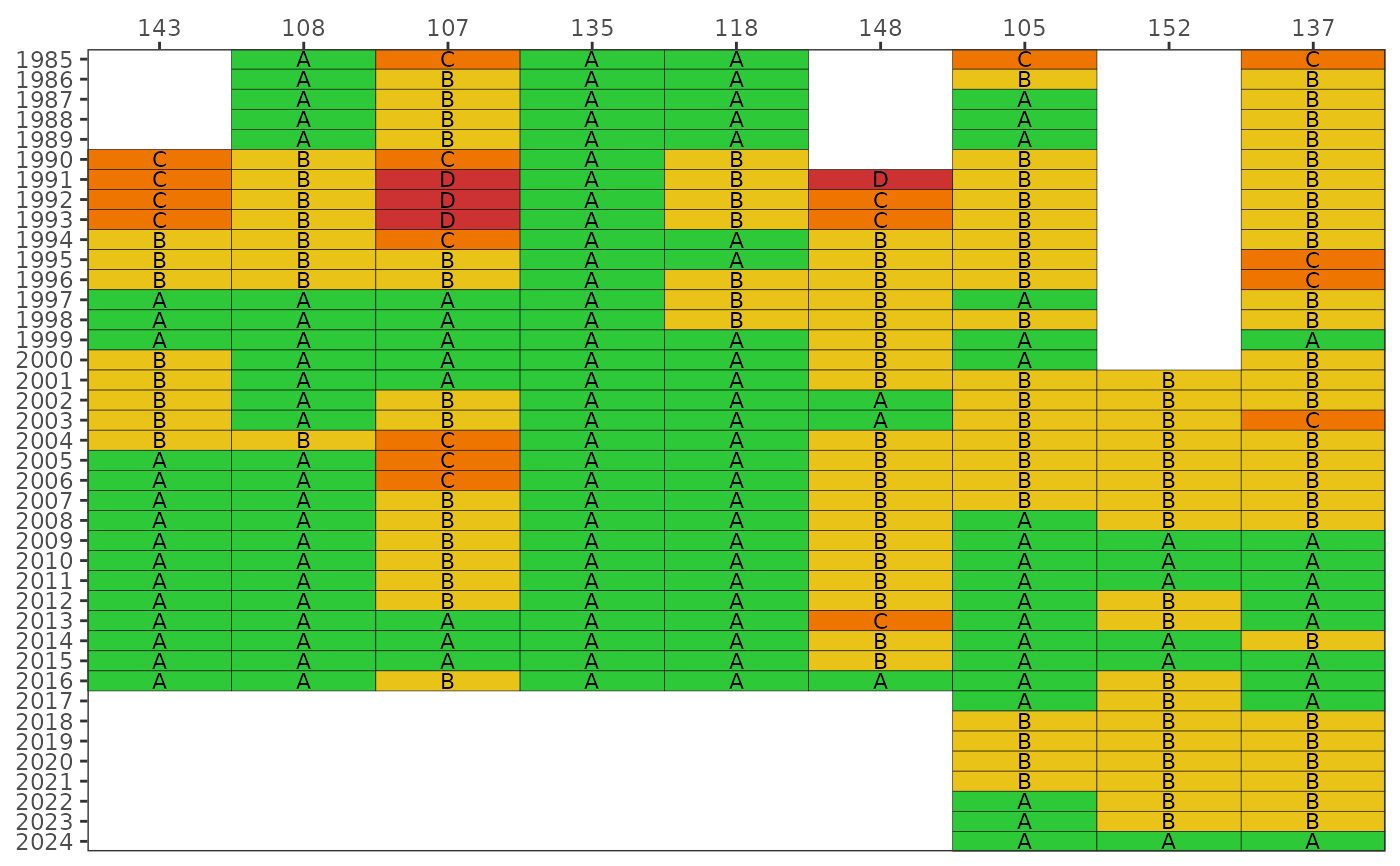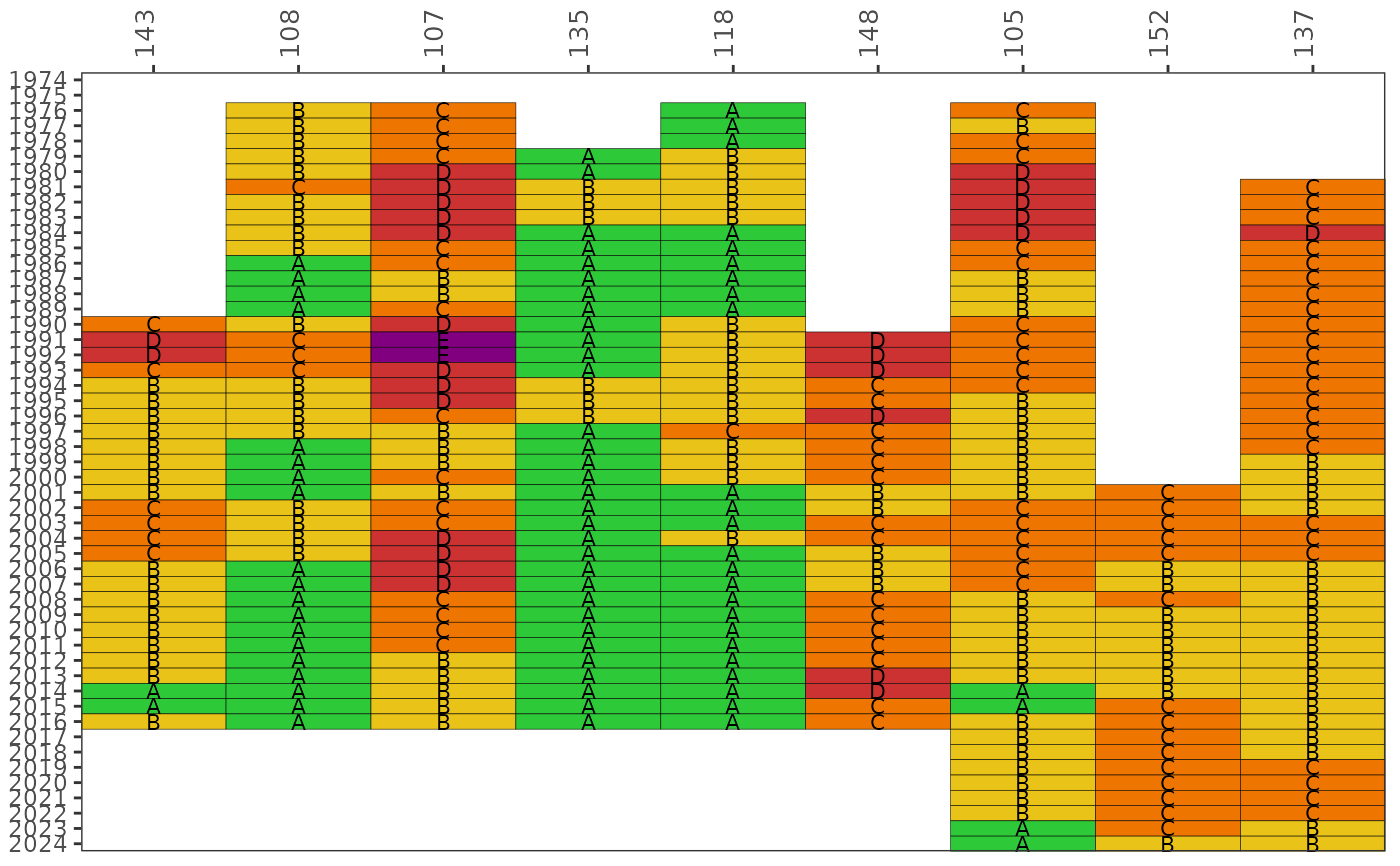
Plot a matrix of Fecal Indicator Bacteria categories over time by station or bay segment
Source:R/show_fibmatrix.R
show_fibmatrix.RdPlot a matrix of Fecal Indicator Bacteria categories over time by station or bay segment
Usage
show_fibmatrix(
fibdata,
yrrng = NULL,
stas = NULL,
bay_segment = NULL,
lagyr = 3,
subset_wetdry = c("all", "wet", "dry"),
precipdata = NULL,
temporal_window = NULL,
wet_threshold = NULL,
txtsz = 3,
asreact = FALSE,
nrows = 10,
family = "sans",
angle = 90,
size = 10,
hjust = 0,
plotly = FALSE,
width = NULL,
height = NULL,
warn = TRUE
)Arguments
- fibdata
input data frame as returned by
read_importfib,read_importentero, orread_importwqp, see details- yrrng
numeric vector indicating min, max years to include, defaults to range of years in data, see details
- stas
optional vector of stations to include, see details
- bay_segment
optional vector of bay segment names to include, supercedes
stasif provided, see details- lagyr
numeric for year lag to calculate categories, see details
- subset_wetdry
character, subset data frame to only wet or dry samples as defined by
wet_thresholdandtemporal_window? Defaults to"all", which will not subset. If"wet"or"dry"is specified,anlz_fibwetdryis called using the further specified parameters, and the data frame is subsetted accordingly.- precipdata
input data frame as returned by
read_importrain. columns should be: station, date (yyyy-mm-dd), rain (in inches). The objectcatchpreciphas this data from 1995-2023 for select Enterococcus stations. IfNULL, defaults tocatchprecip.- temporal_window
numeric; required if
subset_wetdryis not"all". number of days precipitation should be summed over (1 = day of sample only; 2 = day of sample + day before; etc.)- wet_threshold
numeric; required if
subset_wetdryis not"all". inches accumulated through the defined temporal window, above which a sample should be defined as being from a 'wet' time period- txtsz
numeric for size of text in the plot, applies only if
tab = FALSE. Usetxtsz = NULLto suppress.- asreact
logical indicating if a
reactableobject is returned- nrows
if
asreact = TRUE, a numeric specifying number of rows in the table- family
optional chr string indicating font family for text labels
- angle
numeric for angle of x-axis text labels
- size
numeric for size of the x-axis text labels
- hjust
numeric for horizontal justification of x-axis text labels
- plotly
logical if matrix is created using plotly
- width
numeric for width of the plot in pixels, only applies of
plotly = TRUE- height
numeric for height of the plot in pixels, only applies of
plotly = TRUE- warn
logical to print warnings about stations with insufficient data, default
TRUE
Value
A static ggplot object is returned by default. A reactable table is returned if asreact = TRUE. An interactive plotly object is returned if plotly = TRUE.
Details
The matrix color codes years and stations based on the likelihood of fecal indicator bacteria concentrations exceeding 410 CFU / 100 mL for E. coli (fresh) or 130 CFU / 100 mL for Enterococcus (marine). Bay segments are used instead of stations if bay_segment is not NULL and the input data are from read_importentero. The likelihoods are categorized as A, B, C, D, or E (Microbial Water Quality Assessment or MWQA categories) with corresponding colors, where the breakpoints for each category are <10%, 10-30%, 30-50%, 50-75%, and >75% (right-closed). By default, the results for each year are based on a right-centered window that uses the previous two years and the current year to calculate probabilities from the monthly samples (lagyr = 3). Methods and rationale for this categorization scheme are provided by the Florida Department of Environmental Protection, Figure 8 in the document at http://publicfiles.dep.state.fl.us/DEAR/BMAP/Tampa/MST%20Report/Fecal%20BMAP%20DST%20Final%20Report%20--%20June%202008.pdf and Morrison et al. 2009 in the BASIS 5 proceedings.
See anlz_fibmatrix for additional details on the arguments.

